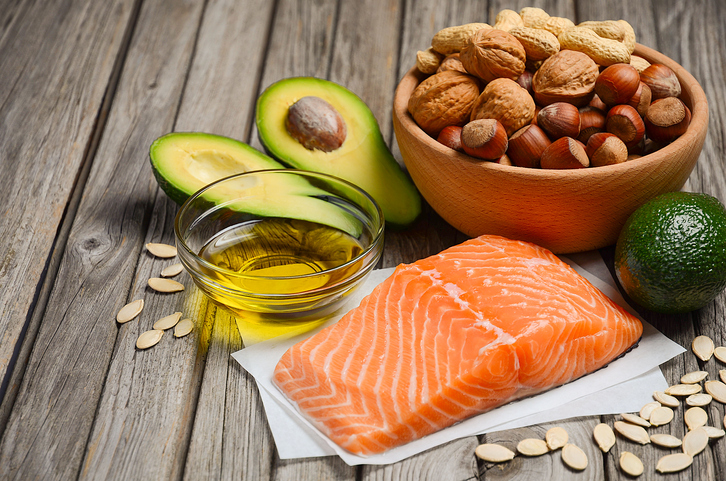Dietary Fat: The Good, The Bad, and The In-Between
By Cheryl Alkon
 Is fat healthy to eat? How does dietary fat affect people with diabetes and their glucose levels? Learn about the types of fat, which types to avoid, and how to make healthier food choices
Is fat healthy to eat? How does dietary fat affect people with diabetes and their glucose levels? Learn about the types of fat, which types to avoid, and how to make healthier food choices
When it comes to feeling full, dietary fat is where it’s at. Fat is one of three macronutrients (along with carbohydrates and protein) that provides nutrition for your body. It also makes you feel fuller faster – at 9 calories per gram, you take in more calories when you eat fat than when you eat the same amount of a carbohydrate or protein (each only has 4 calories per gram).
Some kinds of fat are important for keeping your body healthy:
-
While carbohydrates provide quick energy, fat helps sustain your activity after carbs have been used by your body.
-
It helps keep your hair and skin healthy.
-
It keeps your body warm.
-
It helps your body access nutrients in the food you eat, like vitamins A, D, E and K.
There are different types of dietary fat. Some are currently thought to be unhealthy while others seem to be much better for your body and your heart. How does dietary fat affect diabetes? Here’s a guide to the good, the bad, and the in-between.
What are the different kinds of fat?
Fats are categorized as saturated or unsaturated, according to the Mayo Clinic. In simplest terms, unsaturated fats are healthier than saturated fats.
Saturated fats are found in animal products and are considered an unhealthy type of fat. Saturated fats can raise your cholesterol level, which can increase your risk for heart disease, said Amy Kimberlain, a dietician, Certified Diabetes Care and Education Specialist, and spokesperson for the Academy of Nutrition and Dietetics.
-
Saturated fats include red meat like beef (steak, hamburgers, and hot dogs), pork, and lamb, and full-fat dairy foods such as ice cream and cheese.
-
Trans fats are a type of saturated fat and are also considered unhealthy. Trans fats are created through a process known as partial hydrogenation (hydrogen is added to vegetable oil to turn the liquid oils into solid fats). This helps to increase the shelf-life and flavor stability of foods, said Kimberlain.
-
Trans fats are solid at room temperature and include oils. They may be found in some of the following products: beef fat, pork fat, butter, coconut oil, shortening, and margarine.
Unsaturated fat comes in two categories: monounsaturated fatty acids and polyunsaturated fatty acids. Unsaturated fats are considered a healthy source of fat because they help lower your cholesterol levels and have been shown to benefit your heart, said Kimberlain. These oils are typically liquid at room temperature and are plant-based or fish-based.
-
Monounsaturated fats come from plants. Examples of these foods include peanuts and peanut butter, avocadoes, and oils such as canola, olive, safflower, sunflower, peanut, and sesame.
-
Polyunsaturated fats also can come from plants; foods high in these fats include walnuts, sunflower seeds, flax seeds or flax oil, corn oil, and soybean oil. Another source of these fats is fish, such as salmon, mackerel, herring, albacore tuna, and trout.
Is dietary fat healthy for people with diabetes?
It depends.
“The type of dietary fat consumed matters,” said Kristen Gradney, a spokesperson for the Academy of Nutrition and Dietetics. “Consuming high-fat, saturated fat foods may increase the risk of developing heart disease and hypertension, and may cause complications of diabetes. High fat diets and overconsumption of calories from fat can cause overweight and obesity,” she said.
Saturated fats also increase the amount of cholesterol in the body. Cholesterol is a waxy substance that is produced naturally by the body to make hormones, vitamin D, and substances that help with food digestion. But eating too many high fat foods, especially foods with saturated fat, can raise the level of cholesterol circulating in your blood.
Elevated cholesterol can increase your risk of developing heart problems such as atherosclerosis, where cholesterol and other substances build up inside the arteries and restrict blood flow. This can eventually lead to stroke and heart disease. Check out diaTribe’s infographic on heart disease and diabetes.
But unsaturated fats have health benefits when eaten in moderate amounts, Gradney said. “Unsaturated fats can reduce inflammation and improve cell functioning and cardiovascular risk,” she said. These fats can reduce risk for health complications associated with diabetes, such as heart disease.
Should you avoid eating dietary fat?
No. Healthy fats are a part of a varied, balanced diet, said Gradney. Consuming meals with olive oil, salmon, tuna, plant-based oils and nuts like almonds, along with fruits, vegetables, grains, dairy and low-fat meats (such as skinless chicken or turkey breast, or ground turkey) is all part of a healthy way of eating. Other low-fat sources of protein include egg whites, beans, and fish, such as crab, white fish, shrimp and tuna packed in water, according to the American Cancer Society.
People who have had a heart attack or who are at risk for heart disease, or people who have diabetes, should particularly watch their saturated fat and cholesterol intake. “If a person’s diet contains little other cholesterol and saturated fat, one egg (white and yolk) or two egg whites can be eaten per day as a part of a total overall healthy diet,” said Kimberlain.
“The only other fats that should be avoided are trans fats, which are often found in processed foods such as snack cakes, commercially fried foods, shortening and others,” said Gradney. Trans fats increase blood cholesterol levels “and should be avoided because many times, the foods that contain trans fats also contain saturated fats,” said Kimberlain. “Trans fats are now listed on nutrition facts labels,” Gradney noted. According to the 2010 Dietary Guidelines for Americans and the American Heart Association, trans fats should make up less than one percent of your calories eaten in a day – for someone eating 2,000 calories daily, this amounts to just 20 calories (or fewer!) of trans fats.
A general recommendation is for 20 to 35 percent of your total daily calories to come from healthy, unsaturated fats.
For saturated fats, people with diabetes should aim to eat less than 10 percent of their total daily calories from saturated fat, said Kimberlain. People with a history of heart disease should aim for even less – about 5 or 6 percent. “To put that into perspective, if you need about 2,000 calories a day, that would be no more than about 20 grams of saturated fat a day, or 13 grams a day for people with heart disease,” said Kimberlain.
To decrease the amount of saturated fat you are eating, start by reading the nutrition labels on the foods you eat. You’ll want to avoid foods high in “Trans” or “Saturated” fat.
“A slice of cheese can have six grams of saturated fat or more, so it’s important to identify the sources of fat you are eating and begin to replace saturated fats with unsaturated fats, for example, a handful of nuts” instead of a slice of cheese, Kimberlain said. You can still eat fat in portioned amounts, but you’ll start to eat more healthy fats and fewer unhealthy fats.
Top tips for making healthier food choices
Gradney said when eating out, ask your server for meal modifications that will ensure you eat less high-fat foods. Ask for your meal to be made without butter, or with any high-fat cheese or creamy sauces to be avoided or served on the side. Sauces such as tomato sauce are lower in fat. Gradney also suggests preparing certain dishes, like pizza, at home so you have more control over what you are eating. Making a pizza at home means you can use less cheese, or add more vegetables, to make the dish healthier. That way, “You can still enjoy the foods you love, but by your standards.”
Kimberlain shared three other important tips:
-
Substitute olive oil or grapeseed oil instead of butter, margarine, or shortening when cooking.
-
Eat nuts, nut butters, and seeds throughout the day; add them to salads, yogurt or oatmeal, or eat them as a snack
-
Avocados and olives are a source of healthy fat; try replacing mayonnaise with a slice of avocado in a turkey sandwich, or swap out chips for a few olives as a side to that sandwich.
While dietary fat is an important part of your diet, people with diabetes should do their best to select healthy fats (like fish, nuts, seeds, avocados, and olive oil) instead of unhealthy fats (such as red meat, full-fat dairy foods, or oils that are solid at room temperature, like butter). Remember – no one is perfect, but we can try to keep our bodies as healthy as possible.
You can find out more about diaTribe’s nutrition principles here.
About Cheryl
Cheryl Alkon is a seasoned writer and the author of the book Balancing Pregnancy With Pre-Existing Diabetes: Healthy Mom, Healthy Baby. The book has been called “Hands down, the best book on type 1 diabetes and pregnancy, covering all the major issues that women with type 1 face. It provides excellent tips and secrets for achieving the best management” by Gary Scheiner, the author of Think Like A Pancreas. Since 2010, the book has helped countless women around the world conceive, grow and deliver healthy babies while also dealing with diabetes.
Cheryl covers diabetes and other health and medical topics for various print and online clients. She lives in Massachusetts with her family and holds an undergraduate degree from Brandeis University and a graduate degree from the Columbia University Graduate School of Journalism.
She has lived with type 1 diabetes for more than four decades, since being diagnosed in 1977 at age seven.








